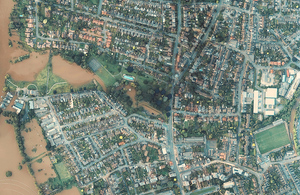Flood Forecasting Centre: a working partnership
The Flood Forecasting Centre is a partnership which reduces flood risk through better forecasting.

Picture of a flood plain
Meteorology and hydrology combined
The Flood Forecasting Centre is an Environment Agency and Met Office partnership.
Former Head of Centre, Crystal Moore explains, “To make a step-change we had to combine disciplines. A weather forecast doesn’t tell you anything about a flood and an inundation model of flooding doesn’t tell you anything without a forecast of how much rain is coming into that system, so there has to be a real co-dependence.”
Saving money through collaboration
Flooding has the potential to:
- impact the national economy
- damage infrastructure
- ruin crops and agricultural land
- block ports or roadways
- bring down communications
- cause social disruption such as evacuation from homes
The average cost of flooding to a business is £82,000, and to a home is £30,000. The social costs are also destructive with families displaced from their homes, sometimes for years.
The FFC reduces the risks and costs of flooding by briefing the emergency services before it happens. This allows a response to be planned, reducing the impact on lives and livelihoods.
Working with other organisations
The FFC consist of professionals from the Met Office and Environment Agency trained in hydrology and meteorology. Examples of their partnership work include:
- consulting Natural Resources Wales and the responder community in our User Group
- sharing data with the Environment Agency to identify places most affected by flooding- for example, highlighting where intense rainfall is most likely to overwhelm drainage systems
- informing the deployment of the Environment Agency’s 40km of temporary barriers - the FFC worked on this project with Highways England, British Telecom, power companies, police and community flood wardens
The FFC can provide information so that temporary barriers are deployed on forecasting triggers. This offers protection to communities that would have flooded in the past through a new technology that didn’t exist just a few years ago.